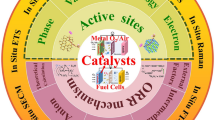Abstract
On the atomic level, we consider a model of the formation of active centers on the surface of a metal, which control the course of corrosion and electrochemical processes. Our quantum-chemical computations demonstrate that a foreign tin atom in a Sn - Ni8 - Ni cluster can favor the dissolution of nickel in an acid medium, and a zinc atom in a Zn - Ni8 - Ni cluster induces its passivation. We also show that the introduction of an oxygen atom into a cluster favors the passivation of nickel.
Similar content being viewed by others
REFERENCES
G. V. Akimov, Theory and Methods of Studying the Corrosion of Metals [in Russian], Akad. Nauk SSSR, Moscow (1945).
Ya. M. Kolotyrkin and G. M. Florianovich, “Interrelation of the corrosion and electrochemical properties of iron, chromium, nickel, and their binary and ternary alloys,” in: VINITI Series in Corrosion and Corrosion Protection [in Russian], Vol. 4, VINITI, Moscow (1975), pp. 5–45.
A. N. Frumkin, Potentials of Zero Charge [in Russian], Nauka, Moscow (1979).
B. N. Kabanov, Electrochemistry of Metals and Adsorption [in Russian], Nauka, Moscow (1966).
M. A. Shluger, F. F. Azhogin, and V. A. Efimov, Corrosion and Protection of Metals [in Russian], Metallurgiya, Moscow (1981).
M. J. Frisch, G. W. Trucks, H. B. Schlegel, et al., Gaussian 92/DFT/-Revision G. 2., Gaussian Inc., Pittsburgh, PA (1993).
P. J. Hay and W. R. Wadt, “Ab initio effective core potential for molecular calculations,” J. Chem. Phys., 82, 270–310 (1985).
J. S. Binkley, J. A. Pople, and W. J. Hehre, “Self-consistent molecular orbital methods. 21. Small split-valence basis sets for first-row elements,” J. Am. Chem. Soc., 102, 939–947 (1980).
V. I. Avdeev, I. I. Zakharov, G. M. Zhidomirov, et al., “Electronic structure of OH adsorbed on nickel,” Zh. Strukt. Khim., 33, No.2, 29–34 (1992).
V. I. Avdeev, I. I. Zakharov, G. M. Zhidomirov, et al., “Ab initio calculations for adsorbed state of OH group on Ni(110),” React. Kinet. Catal. Lett., 45, No.1, 61–66 (1991).
V. I. Avdeev, I. I. Zakharov, and G. M. Zhidomirov, “Theoretical analysis of the dissociative adsorption of H2O on Ni(100),” Zh. Strukt. Khim., 33, No.2, 35–41 (1992).
I. I. Zakharov, V. I. Avdeev, and G. M. Zhidomirov, “Non-empirical cluster model calculations of the adsorption of H2O on Ni(111),” Surf. Sci., 277, 407–413 (1992).
V. I. Pokhmurs’kyi, M. S. Khoma, V. I. Kopylets’, and S. A. Kornii, “An investigation of the initial stage of selective dissolution of zinc-aluminum alloys in a chloride-containing medium,” Fiz.-Khim. Mekh. Mater., 39, No.3, 76–80 (2003).
A. V. Vvedenskii and I. K. Marshakov, “Initial stage of the anodic dissolution of copper-gold alloys in chloride and sulfate solutions,” Elektrokhimiya, 33, No.3, 298–307 (1997).
D. Landolt, “Mass transfer processes in the course of anodic dissolution of metals,” Elektrokhimiya, 31, No.3, 228–234 (1995).
A. S. Sultanov, Mendeleev’s Chemical Theory of Catalysis and Its Subsequent Development [in Russian], Akad. Nauk Uzb. SSR, Tashkent (1961).
E. K. Oshe, “Anodic defect formation, nonstoichiometry, and phase transitions in oxide films on nickel in an acid solution,” Elektrokhimiya, 31, No.3, 307–312 (1995).
I. I. Zakharov, I. N. Shapovalova, O. I. Zakharova, et al., “Nonempirical calculation of the structure density of surface compounds of ozone and oxygen on Ni(110) by the functional method,” Zh. Strukt. Khim., 42, No.6, 1064–1070 (2001).
N. F. Tyupalo and O. I. Kolbasina, “On the mechanism of ozone reactions with compounds of metals of variable valence,” Visn. Skhidn. Derzh. Univer., No. 4(20), 31–35 (1999).
G. O. Tatarchenko, “On the mechanism of passivation of metals in acid ozonized media,” Fiz.-Khim. Mekh. Mater., 37, Special Issue No. 2, 73–77 (2001).
Author information
Authors and Affiliations
Additional information
__________
Translated from Fizyko-Khimichna Mekhanika Materialiv, Vol. 41, No. 1, pp. 12–18, January–February, 2005.
Rights and permissions
About this article
Cite this article
Shapovalova, I.N., Tatarchenko, G.O., Zakharov, I.I. et al. A Quantum-Chemical Model of Active Centers of Electrochemical Corrosion of Metals. Mater Sci 41, 7–14 (2005). https://doi.org/10.1007/s11003-005-0126-6
Received:
Issue Date:
DOI: https://doi.org/10.1007/s11003-005-0126-6




